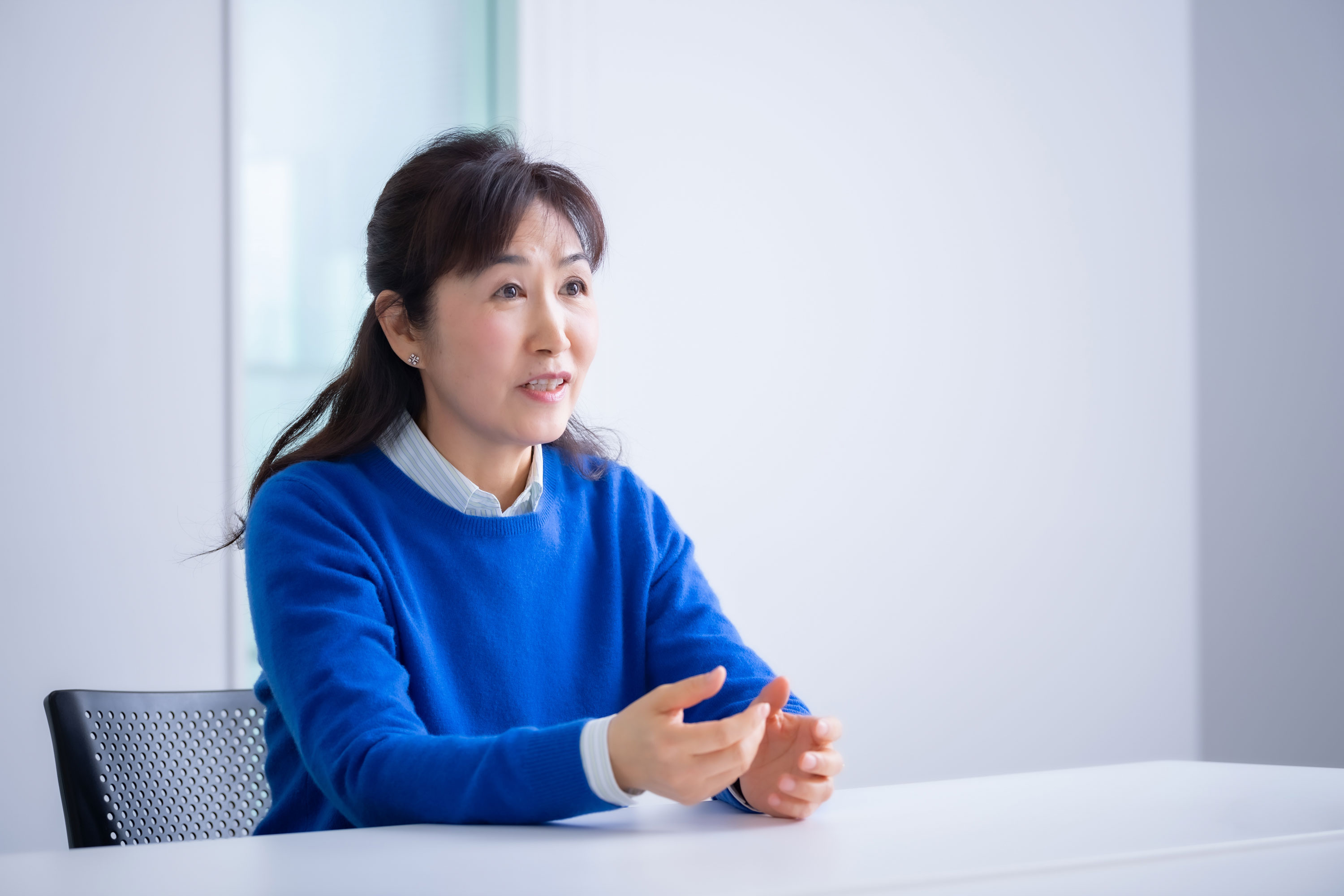An interview with Jinhua Ye, MANA Principal Investigator
Jinhua Ye
Group Leader, Photocatalytic Materials Group, Nano-Materials Field, WPI-MANA
Since joining WPI-MANA in 2007, Dr. Jinhua Ye has focused on research and development of photo-functional materials and their applications in the fields of environment preservation and new energy production. In addition to her position at WPI-MANA, she is an adjunct professor of Hokkaido University, and a fellow of the Royal Society of Chemistry. Dr. Ye is a highly cited researcher, having published over 600 papers in high-quality research journals, which have been cited more than 50,000 times.
Photo-functional materials offer
a new way to combat climate change
− Thank you for meeting with us today. To start with, could you give us a rundown of your current research?
Basically, I am studying photo-functional materials and their applications in the fields of environment preservation and new energy production. I’m developing catalysts for converting CO2 into hydrocarbons, using sunlight to power the reactions. For this I am focusing on finding materials to act as catalysts for the reactions, and broadening our understanding of how to make these reactions more efficient and selective.
It’s a three-step process. First we ask, “How can we absorb more light?” In particular visible light and infrared, not just UV. To do that, we need to tune the band gap of the material. If it’s too wide, it will only absorb a small part of the UV light. But if it’s too narrow, the generated electron hole reduction activity or oxidation activity will be limited. So we need to find some kind of compromise.
And then also, if it is to help the reaction, we need the reduction energy of this conduction band to be more negative than some reaction. On the other hand, we also need to adjust the valence band position. So we think about all these things, and then we can have a guideline for what kind of electronic structure or element is better, or what kind of crystallinity or conductivity it should have. The second step is to keep the electron and hole separated and move to the surface, so we need to have some way to create a potential gradient from the inside of the nanoparticle to the surface. We usually construct some kind of nanometer-scaled hybrid structure with a nanometal on the surface which has a larger work function to capture photoexcited electrons easily. This nanometal is called a “co-catalyst,” which is the critical point in the third step: accelerate surface reaction and tune selectivity.
Inspired by nature
− Do you ever use a biomimetic approach?
Oh, sure. We have tried a bio-hybrid system of PS II and WO3 to do artificial photosynthesis. In fact, several approaches are running in parallel right now. The photocatalytic materials we are doing are one of the major trends; photo-biocatalysis is also attracting increasing attention. Each approach has its own advantages and disadvantages, but at the moment, we cannot see that any is overwhelmingly better than the other. But for photocatalytic materials, it's basically oxide semiconductor materials, so they are more stable and easier in terms of fabrication, cost and control.
I was recently invited to write a review paper on CO2. So I wrote on carbon recycling using sunlight. I described the possible approaches for tackling the CO2 issue, and my future view of the technology. I systematically analyzed not only the efficiency, selectivity and durability of each approach, but also its cost and impact on the environment.
− Will the technology you're working on be involved in the sustainability effort? Will it make a difference?
Reducing CO2 is now a major concern around the world. We need to keep the economy rolling, but we also need to reduce CO2. There are numerous strategies to sequester the CO2 such as burying it, but I think utilizing sunlight to convert the CO2 into fuel is a better way. Sunlight is free, and we can utilize it to convert CO2 into something useful, such as hydrocarbons or some other chemicals, for a new source of energy. We can decrease CO2 and global warming and create a new form of energy -- we can accomplish two goals with one action.

− Your work on photo-functional materials has a clear relevance to MANA’s Four Grand Challenges (Nano PerceptiveSystems, Nanoarchitectonic Artificial Brain, Room-temperature Superconductivity and Practical ArtificialPhotosynthesis). As for MANA in general, what direction should the organization take?
That is quite difficult to answer because we have lots of experts in different research areas at MANA. This diversity is a real strength of MANA, and everyone has their own research interest. Definitely, all the four Grand Challenges are very important and exciting. For me, how to utilize solar energy to produce renewable energy is my main interest, so I started working on “Practical Artificial Photosynthesis” when I joined MANA 14 years ago. I think that for MANA in general, the direction should be sustainability -- we must do work that can contribute to the realization of sustainability, in energy and other fields.
High impact research
− You're a highly cited researcher at MANA. This must be a growing field of interest worldwide.
It’s growing very quickly. When I started in this field, I tried to fully utilize my background to bring some new ideas into the traditional catalysis field, and so I used a slightly different approach from others, so we could have some high impact results very quickly. Later on, I continued this kind of effort, so we were able to lead the field and always keep ahead of the game. We have produced a lot of high-impact work, and results published in good journals, so we get lots of citations from others in the field.
− What sparked your interest in this field?
I'm a big science fiction fan. I love to watch science fiction movies, over and over. When I was in elementary school, I read a novel by a Chinese science fiction writer, in which he describes a beautiful castle, all made of diamond. And this diamond is converted from graphite.
This is actually possible, though right now, the technology to do it is very limited; you couldn’t build such a beautiful castle, or anything of any size. But I realized, “Oh, the same element, carbon, can have totally different properties.” I think that strongly affected me and later on, I started my dream of doing scientific research to develop new materials and study phase transformations.
− A lot of young researchers and students come here. Do you have any advice for people considering a career in this field?
First of all, it is very important to find something you are really interested in -- something that really excites you -- and someday your dreams will come true. In my case, I started my career researching shape memory alloys and later worked on high temperature superconductors. But finally, I arrived at artificial photosynthesis, which is a dream closer to something I imagined from my childhood.

Looking ahead
What are some future directions of your research?
Right now we are coming to a good stage, I think. But, of course, we still need to have a deeper understanding of the mechanism. So we will advance and deepen our understanding at the atomic and molecular level of this catalytic reaction. Of course, we will continue to develop new materials based on this understanding of the mechanism. We will also design a prototype reactor. And in several years, I hope, we will be able to show it to the world.
Finally, what is your vision for the future?
My dream is to develop a material that results in a system to convert CO2 into fuel -- a machine into which we pour CO2 and water, and fuel comes out the other side, powered just with sunshine. This could be a revolution -- and I hope to make it a reality someday.
#####

